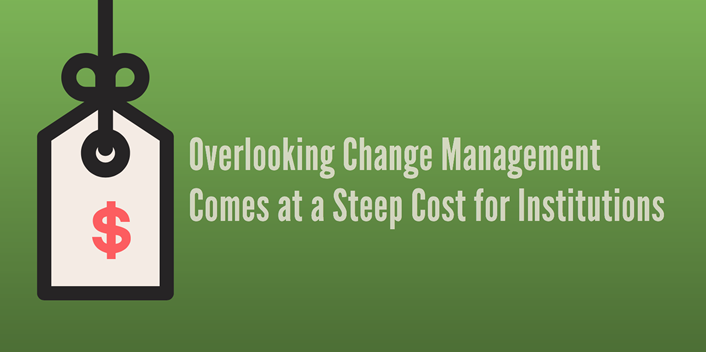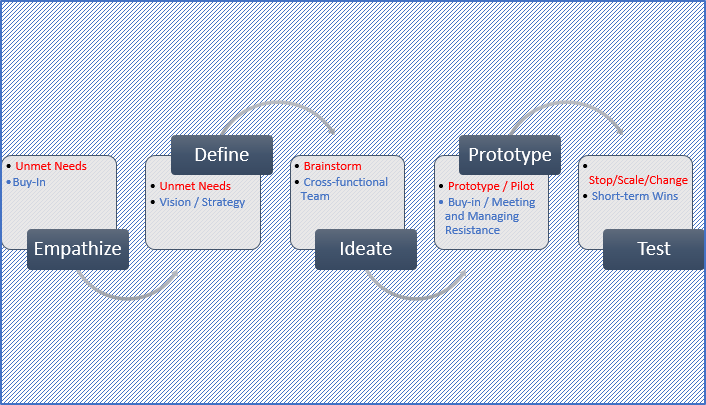
Design Thinking (DT) is working its way into the consciousness and practices of business, nonprofits and government. Both the principles of DT (primarily, being human-centered in one's approach to problem-solving) and the practices of DT (the five step process in the graphic below) are helpful as organizations and institutions explore innovation in the education space.

On October 31, we'll touch on both, spending a half-day focusing on the latter with higher education leaders who are delving into innovation as part of the Diana G. Oblinger Forum in Philadelphia. The Forum is a 2017 EDUCAUSE Annual Conference leadership program that illuminates the key role technology and data play in advancing academic transformation, and provides actionable opportunities for IT and academic leaders to partner on student success.
(If you're planning to attend the EDUCAUSE Annual Conference and you'd like to join the session, click here.)
Change management principles offer great support for innovators, but often aren't considered until late in the game when issues have already arisen. Considering change management alongside the DT-supported innovation process gives innovations a much better chance at succeeding. The text adjacent to each DT step above shows how the DT process generally meshes with the process of innovation (in red) and the discipline of change management (in blue). Tying all three strands together results in initiatives with a stronger chance of success and a stronger culture of innovation overall.
Empathy
The DT principle animating this step is this: the best designs are human-centered. Putting human beings at the center of the process ensures humane and helpful results. This is why the DT process requires focus groups, interviews, immersion experiences, etc., with the target audience. These tools create an entirely different level of empathy and offer unique insights that can't be gleaned from a survey. How does the target population see this innovation benefitting them?
Example: Harper College's (Ill.) focus groups found that incoming students didn't want just advising — they wanted coaching on how to build a life using their education as a jumping off point.
From a change management perspective, centering your innovations on the actual needs of your target groups as they have stated them paves the way for a smoother implementation.
Define
Framing the problem is the foundation to the design. Starting with the right question(s) is everything. This principle can significantly change a process by redefining what was initially the challenge or issue. Being open to revising the question can be pivotal to arriving at a working solution. Embrace the change if it presents itself, and watch what happens when you let go of your original ideas and beliefs. Usually something much more compelling and fitting emerges.
Example: Montgomery County Community College (Penn.) let go of their idea for a MOOC and adapted to student needs around financial literacy. After immersing themselves with students, they reframed their question from “How do we build a MOOC around financial literacy?” to “How do we get students just-in-time information to make financial decisions related to college?” It was a subtle but significant shift that completely changed the solution they generated.
The corresponding change management principle focuses on the need for a clear vision and strategy. Asking the right question surfaces a strong, clear vision and enables development of a clear pathway. This is probably the most overlooked and most critical piece for innovation and change management. Every innovation is a change that require stakeholders and target audiences to engage and behave differently; no one is going to do this without knowing why. Coupling the defining step of DT with the vision/strategy step of change management ensures the innovation is compelling and urgent and brings forward solid steps to viable solutions.
Ideate
Innovation comes from a clash of ideas. By grafting onto ideas and transforming ideas from different sources to fit our context, we get the best solutions. Rare is the transformative idea that emerges fully formed from a single person or source. Drawing from different people, departments or even industries for suggestions will make the solution stronger. Is your change/innovation team balanced and diverse? Look at what other industries are doing to see if trending modalities and themes have a place in your plan.
Example: Austin Peay State University drew on e-Harmony for inspiration when designing their major-selection tool for students.
Change management offers support here as well, by emphasizing the use of a cross-functional team that covers different organizational levels and communication styles. When you enlist a diverse cross-functional team, you're more likely to generate productive and creative brainstorming for solutions.
Prototype
Showing is better than telling. Experiencing solutions is far more engaging and illuminating than telling people about them. Think about how much more you learn from a sample of food than a description of it.
Example: University of Maryland University College created a mini prototype of a course using a small number of students and a few experiences in order to get feedback before building out their plan.
The prototyping stage is an excellent point for generating insights that will help the change management plan when the time comes to scale or iterate. By paying attention during this stage to what is not resonating with your target audiences — or areas that are generating resistance from stakeholders — you can better anticipate resistance and plan for buy-in with your larger, at-scale audiences. Resistance is a normal part of the process. Failing to anticipate and/or respond to it will derail or kill the process.
Test
The difference between creative people and innovative people is action. Live testing and iterating is what brings innovations to life.
Examples: All around higher education. Check out what the following institutions are doing (iPASS, BMI).
Change management principles also support this bias for action. One of the most important steps to implementation success involves grabbing short-term wins and communicating about them to generate more momentum and energy in support of the plan. If the prototype or test did not yield stellar results, talk about what was learned and how these lessons can be applied to future innovations.
The best DT process is actually comprised of six steps — the first five being the process popularized by IDEO and an extra (yet incredibly necessary) one: the change management process that supports it.
Holly Morris does higher ed strategy/innovation consulting and leader/team development work in Seattle, Washington.
